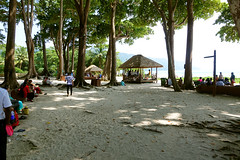Ever since I sojourned on the wondrous and fascinating Andaman and Nicobar group of islands early this season, I have been wanting to know more about the history and geography of these tiny bits of lush green landmasses that are enclosed by ink black seas. Despite a plethora of travel guides and books available in the market, frankly speaking, there aren’t any good books on the Andamans and Nicobars that would qualify to be a piece of travel writing. I came across this book in a popular bookstore at Hyderabad on my most recent visit.
I must say that this is by far one of the best travel literatures on the Andamans and Nicobars available in a print format. Sharing anecdotes and stories from the times when the civilisation on this group of islands was still infant, Protiva Gupta’s book proves to be a rich storehouse of information. Through her book, Protiva not only recaps the history of this unique archipelago but captivatingly tells its many mysteries, folklore as well as the murmurs of the island life in the 1960s. With the highlight of the book being the researched narration of penal life in the Andamans, her travels to the Nicobars also deserves a mention.
The author, Protiva was born in 1918 and spent her childhood in Shimla and Delhi. It was after her marriage in 1942 to a civil engineer, who was then working with the Government of India, that she got multiple opportunities to travel across India including the Andaman and Nicobar Islands where the couple lived for four years (1961 to 1964). At the time she lived in the cluster of these tiny islands, Protiva was not only captivated by their stunning beauty but its recent history as well. During those days not much was known to the outer world about the Andamans and Nicobars except for its geography, an archipelago lying south east of the Indian mainland, in the Bay of Bengal. Ship used to be the only practical means of reaching the islands in those days. Ferrying passengers or transporting loads happened once a month and took nearly five days in touching Port Blair from Calcutta or Madras.
To me, the most attention grabbing part of the book is the description and stories of the aborigines, arrival of the British and the connection of the islands with India’s freedom struggle. Her narration underscores the times when the civilisation started to gain a foothold at these islands and the manner in which settlements were established by refuge seekers from East Pakistan. The times she spent in these islands are also tantamount to the period that is responsible for bringing many critical changes as well as development in the islands after India gained independence.
This fascinating travel book is not only based on a detailed research which she undertook to write it but is also a result of her extensive travels within the archipelago. Her excursion to Nicobars is particularly interesting. The book Green Islands of the Andamans and Nicobars was originally written in Bengali language as a series of stories and published in a vernacular magazine under two separate heads: the Andamans and the Nicobars. Protiva later compiled the stories into two books which were published in late 1960s. First published in 2013, this edition of the book is an English translation of the two Bengali books compiled into one. The translation of this book is expressively done by Meena Gupta, daughter of the author.
Today, the Andamans and Nicobars as described in her book may have changed beyond recognition but the exquisiteness of the landscape – a beautiful combination of sea, hills and forests – remains. Now with improvement in communication and transportation, habitation in the islands has increased manifolds. The once hostile native tribes have also been befriended. Unfortunately, in the process, much of the wild and untamed beauty has been lost. With the ever increasing avenues of tourism, the islands today attract a very large number of visitors. Despite the destructive tsunami of 2004, the Andamans continue to gain popularity among tourists.
The book should be of particular interest to a person who has visited these islands and wants to know more. The only thing I regret about this book is the lack of photographs, in fact, there is none. I’d totally recommend this book to anyone who feels mesmerized by the Andaman and Nicobar Islands. In about 250 pages, the author would intensify your desire to visit these islands again; this time with an informed perspective. The book is available at Rs 299 on amazon.in.
 bNomadic
bNomadic










